The modern B2B stack is hungry for live data. Your CRM, pricing models, and market insights are only as good as the inputs you feed them. And increasingly, the richest source of those inputs? Public websites. In 2025, web extracting isn’t just for the techies anymore—it’s become a daily habit for sales, marketing, and operations teams who want to turn the web’s chaos into clean, actionable data. And honestly, with the right web extractor, you can go from “Ugh, not another copy-paste marathon” to “Wow, I just built a lead list while sipping my coffee.”
If you’re looking to join the ranks of data-driven teams (without needing a PhD in XPath), you’re in the right place. I’ve spent years in SaaS, automation, and AI—first at Automation Anywhere, then , and now as co-founder of . I’ve seen firsthand how web extractor tools have gone from geeky sidekick to business MVP. In this guide, I’ll break down the 12 best web extractors for 2025—covering everything from AI-powered assistants to classic browser extensions—so you can find the perfect fit for your workflow, your team, and your sanity.
Why Web Extractors Matter for Business in 2025
Let’s be real: the web is the world’s biggest (and messiest) database. And in 2025, the companies that know how to turn that mess into insight are the ones pulling ahead. According to , data-driven firms are 5% more productive and 6% more profitable than their peers. That’s not just a rounding error—it’s a real edge.
Web extractor tools (sometimes called web page extractors or web extracting solutions) are the secret sauce here. They let sales teams scrape public directories, social media, and company websites to build targeted prospect lists—no more buying outdated lead sheets or praying your intern doesn’t quit mid-copy-paste (). Marketing and ecommerce teams use web extractors to track competitor pricing, monitor stock levels, and benchmark products in real time—John Lewis, for example, credits web scraping with a 4% sales lift just from smarter pricing ().
But it’s not just about the numbers. Web extractors save huge amounts of time (one user reported saving “hundreds of hours” by automating data collection) and eliminate human error (). Operations teams now set up scrapers to continuously gather data that would have taken interns weeks—freeing up hours that were once lost to tedious copy-paste tasks (). And with AI-driven extractors, even non-technical users can transform websites into structured data for analysis ().
Bottom line? If you’re not using a web extractor in 2025, you’re probably leaving insights (and money) on the table.
How We Chose the Top 12 Web Extractors
With so many web extracting tools out there, how do you pick the right one? I looked at dozens of options, but only 12 made the cut for this list. Here’s what I focused on:
- Ease of Use: Can a non-technical user get started quickly without writing code? I prioritized no-code or low-code tools with intuitive interfaces ().
- AI Capabilities: Next-gen tools that use AI to simplify scraping—like automatically detecting data fields, handling site navigation, or letting you describe your needs in plain English ().
- Automation & Scheduling: The best web extractors run on autopilot. I picked tools that support scheduling recurring scrapes or monitoring of websites ().
- Data Export & Integration: Can you easily export to Excel, Google Sheets, Airtable, or Notion? Bonus points for workflow integrations ().
- Scalability and Reliability: Whether you’re scraping one page or thousands, these tools can handle it. I also considered user reviews for reliability.
- Business-Focused Use Cases: I emphasized tools that are popular with sales, marketing, ecommerce, and operations teams—not just developers.
Some tools here are AI-powered newcomers, others are industry classics. All of them are designed to help you turn the web into your own business database—without a headache.
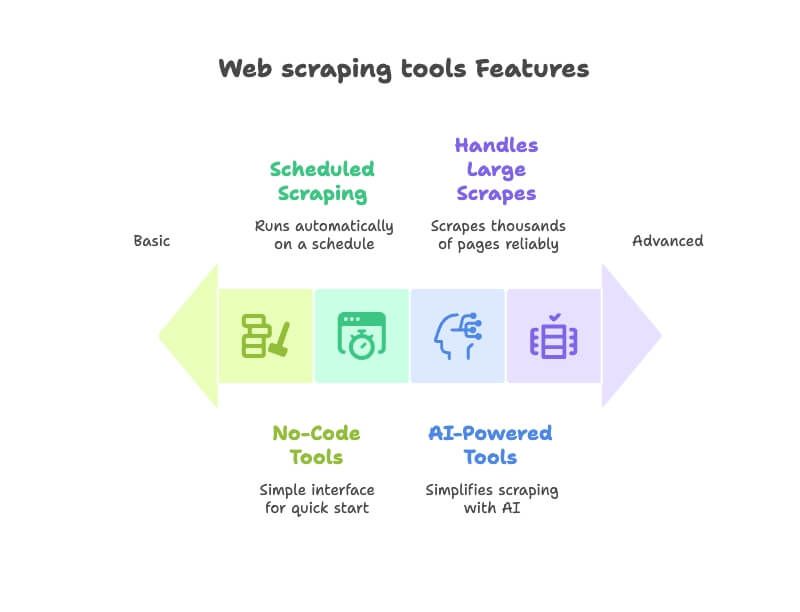
Quick Comparison: Web Extractor Tools at a Glance
Here’s a snapshot of the 12 web extractor tools I’ll cover, so you can see how they stack up:
| Tool | AI Automation | Ease of Use | Best Use Case |
|---|---|---|---|
| Thunderbit | Yes – AI suggests fields and handles pages automatically | Very easy (Chrome extension, no code) | Fast scraping for leads, prices, etc. by non-technical users who want results in minutes. |
| Octoparse | Limited (template-based, no AI) | Easy for most (visual drag-and-drop interface) | Custom scraping workflows (with logins, pagination) for analysts who want control without coding. |
| Browse AI | Partial – point-and-click "robots" | Easy (no-code, cloud-based) | Automated monitoring of data (prices, listings, etc.) on a schedule, with alerts and integrations. |
| WebScraper.io | No (manual configuration) | Moderate (browser extension with sitemap setup) | Visual scraping of multi-level websites for users willing to configure steps. |
| ScraperAPI | N/A (API service, handles proxies via API) | Requires coding (API integration) | High-volume web data extraction for tech teams—proxies & CAPTCHAs handled for large-scale scrapes. |
| Data Miner | No | Very easy (browser extension with one-click templates) | Quick one-off data extraction from pages (especially tables or lists) directly into CSV/Excel. |
| Simplescraper | No (some AI-assisted features) | Easy (point-and-click recipe builder) | No-code scraping with integrations—great for sending web data to Google Sheets, Airtable, or API. |
| Instant Data Scraper | Yes – auto-detects data tables | Very easy (just click, no setup) | Instant free scraping of HTML tables and lists by anyone (ideal for quick data grabs). |
| ScrapeStorm | Yes – AI identifies page elements | Easy (visual interface; cross-platform app) | Large-scale or complex scraping projects without coding, including scheduled crawls. |
| Apify | Some – pre-built "actor" bots available | Moderate (web interface; coding optional) | Scalable cloud scraping and automation via ready-made or custom scripts. |
| ParseHub | No (scriptless but manual setup) | Easy for basic use (visual editor; desktop app) | Scraping dynamic or complex sites (AJAX content) through a no-code interface. |
| OutWit Hub | No | Easy (desktop GUI application) | Simple, offline data extraction and content archiving for small projects. |
Most tools offer a free tier or trial and tiered subscriptions. The focus here is on capabilities and use cases rather than cost.
Thunderbit: The AI-Powered Web Extractor for Everyone
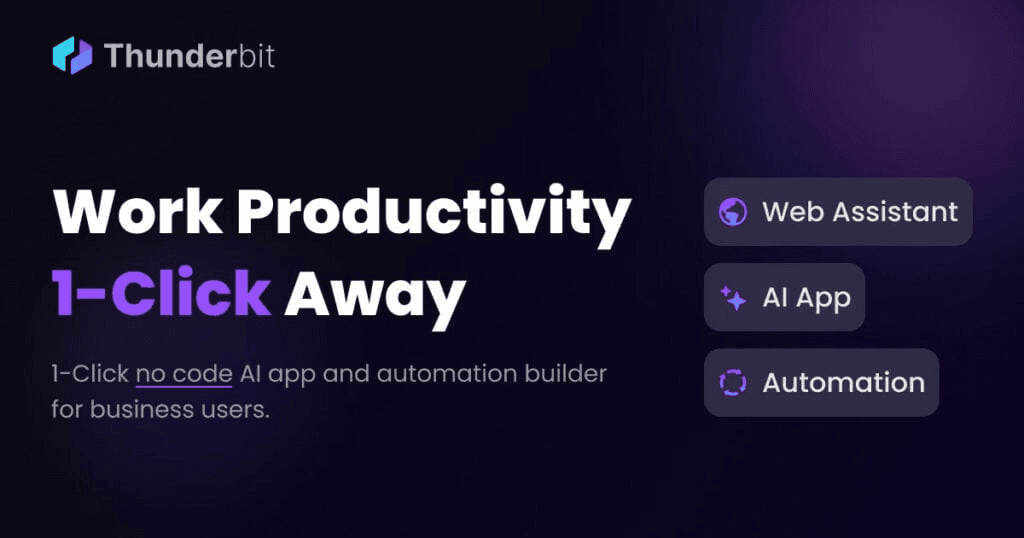
Let’s kick things off with Thunderbit—yes, that’s my baby, but hear me out. The web extracting industry is shifting from “configure your own scraper” to “just tell the AI what you want.” Thunderbit is the first tool I’ve seen (and helped build) that truly feels like an AI data assistant instead of just another “crawler.”
With , you don’t mess with XPath, CSS selectors, or regular expressions. You just describe the data you want in plain English—like “grab the title, author, and date from this page”—and Thunderbit’s AI does the rest (). Click “AI Suggest Fields,” and Thunderbit reads the page, recommends columns, and even handles subpages and pagination automatically ().
But it’s not just about grabbing data. Thunderbit can clean, transform, categorize, and even translate fields as it scrapes. Need to standardize phone numbers, summarize descriptions, or translate product names? Just add a quick instruction, and the AI handles it. And when you’re done, you can export straight to Excel, Google Sheets, Airtable, or Notion ().
What really sets Thunderbit apart is the zero setup, zero learning curve. It’s a Chrome extension, so you’re up and running in seconds. No plugins, no configuration, no technical jargon. That’s why it’s become a favorite for sales, marketing, and operations teams who need results—fast (). The free tier lets you try out the full workflow, and paid plans are affordable (think “less than your monthly coffee budget” for most teams).
If you want to see what AI web extracting feels like in 2025, and give it a spin. Your copy-paste days might just be over.
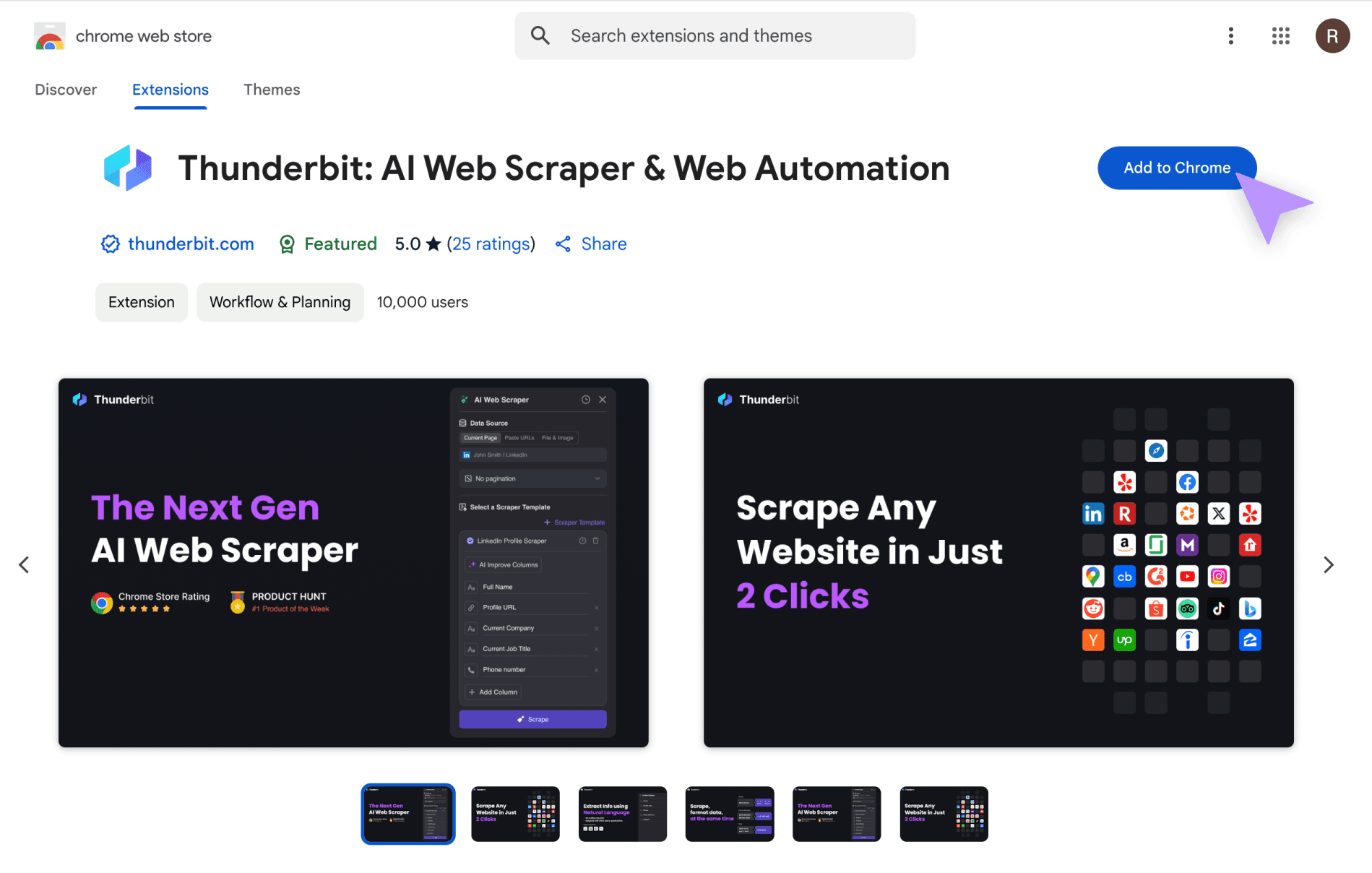
Octoparse: Visual Web Extractor for Custom Workflows
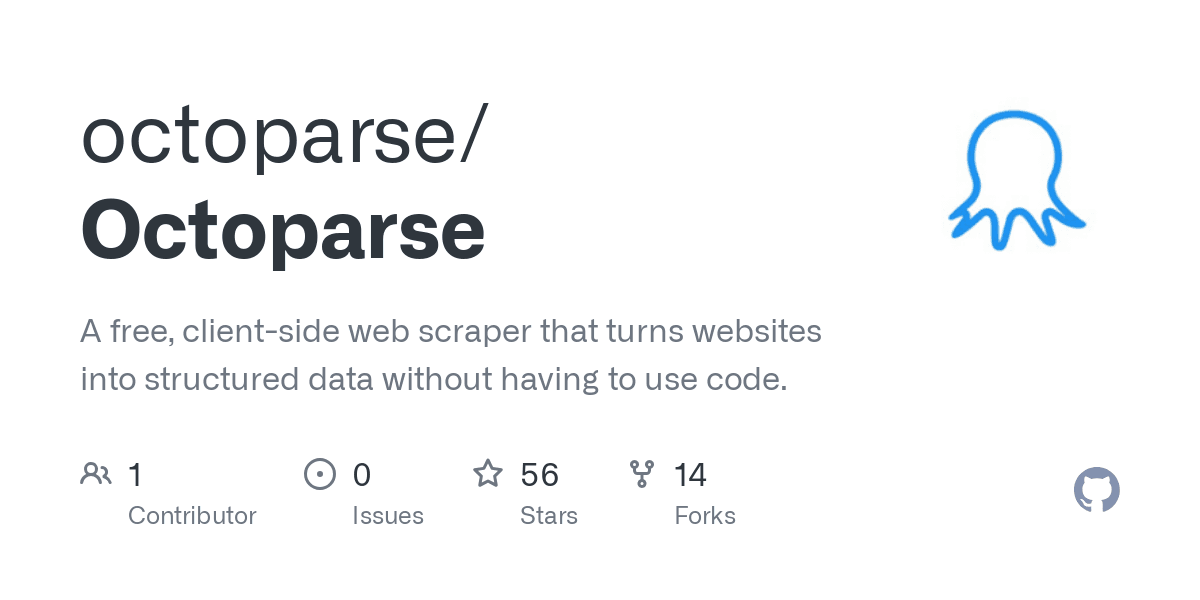
Octoparse is a classic in the visual web scraping world. It’s a desktop app with a point-and-click interface—you interact with the webpage, select the data you want, and Octoparse builds a workflow behind the scenes (). You can handle logins, set up pagination, and even automate form submissions, all without writing code.
One of Octoparse’s strengths is its library of 500+ pre-built templates for popular sites (Amazon, Twitter, LinkedIn, etc.), so you can often just load a template and start extracting (). For more complex sites, you can switch to manual mode and visually configure each step. Octoparse supports scraping content that loads after clicks or scrolling, and it can work with proxies and solve CAPTCHAs for tougher jobs. There’s also a cloud-based option for scheduling and running scrapes at scale.
The trade-off? There’s a bit of a learning curve, especially if you want to handle advanced scenarios. But for non-programmers and data analysts who want a customized scraping workflow without code, Octoparse is a solid choice ().
Browse AI: Automated Web Extracting with Prebuilt Robots
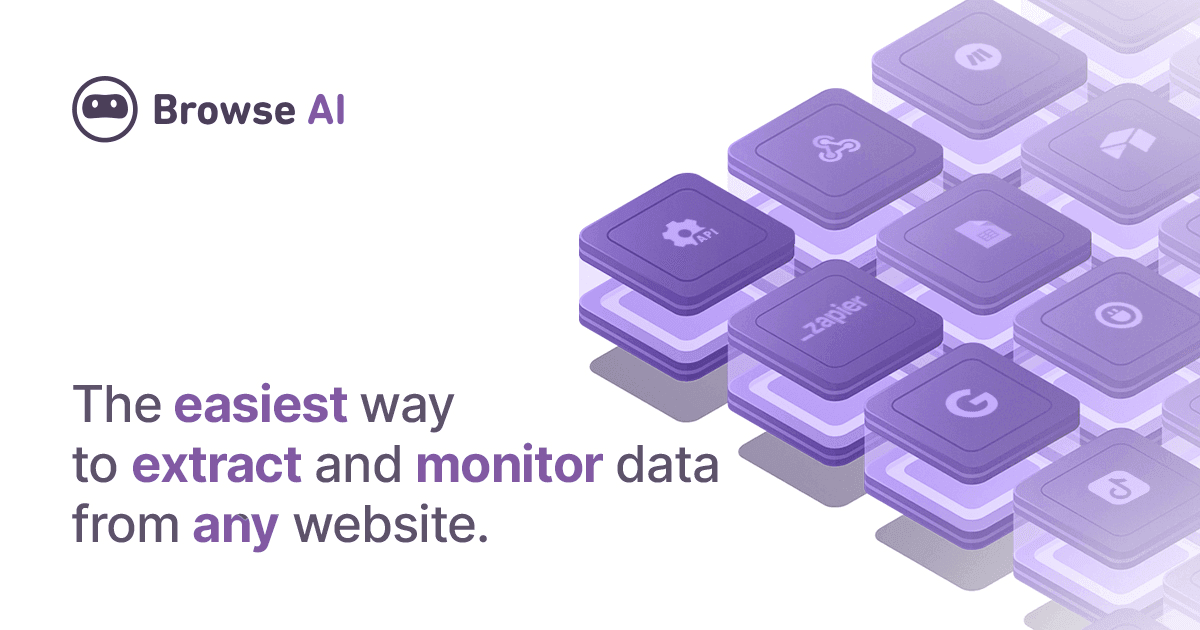
Browse AI takes a fun approach: you train a “robot” by pointing and clicking on the data you want, and it learns to extract that data across similar pages (). It’s all cloud-based and no-code, so you don’t have to worry about scripts or servers.
What makes Browse AI stand out is its automation and monitoring. You can schedule your robots to run on a regular basis and get alerts when data changes (like a competitor drops their price or a new job listing appears). They also offer a library of prebuilt robots for common tasks—so you can often start with a ready-made solution and tweak it as needed ().
Browse AI integrates with thousands of apps via Zapier and Make, and can export data directly to Google Sheets or via API/webhooks (). It’s a great fit for continuous monitoring and recurring data collection, especially if you want hands-off alerts and integrations.
WebScraper.io: Browser-Based Web Page Extractor
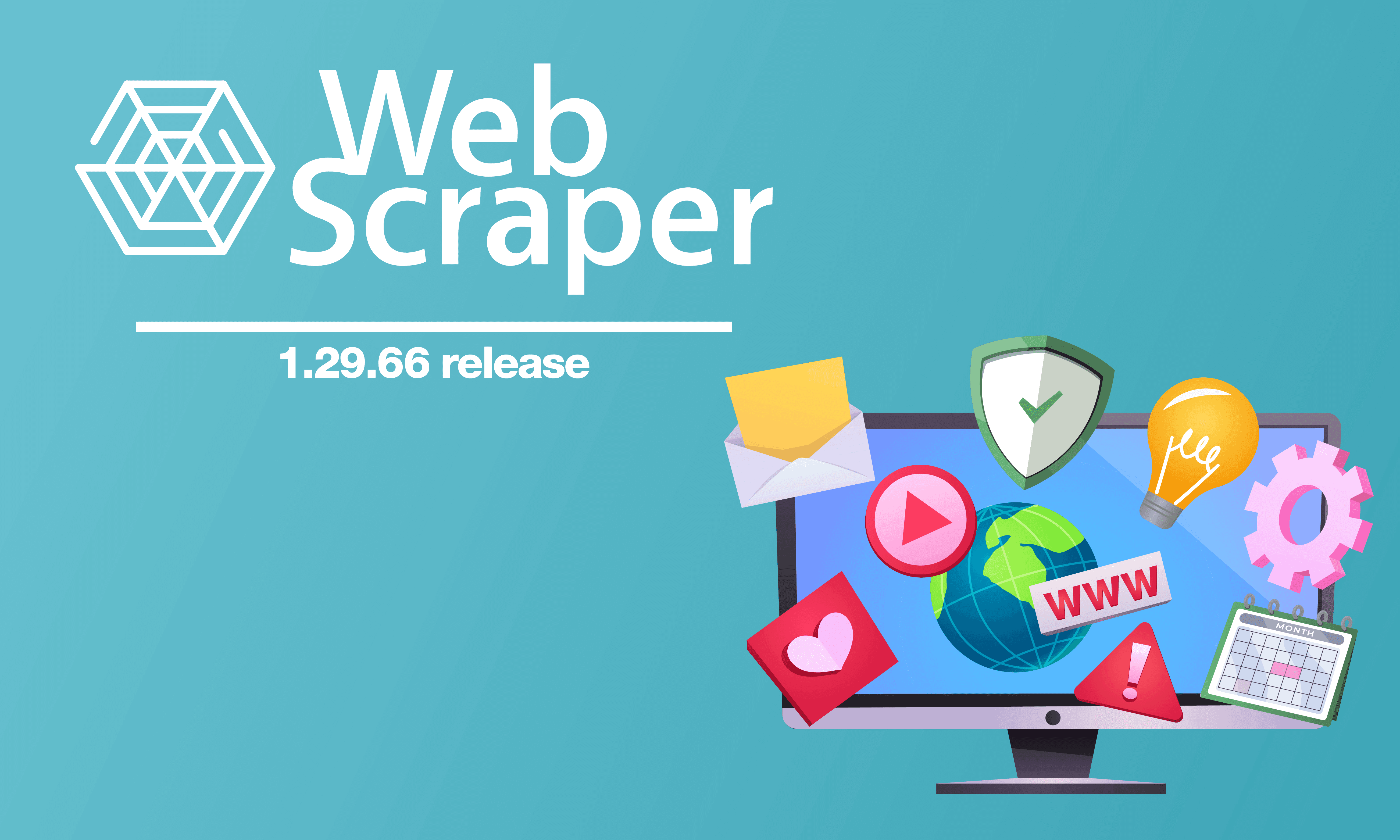
WebScraper.io (often just called “Web Scraper”) is a browser extension that lets you build “sitemaps”—visual plans for how to navigate a website and what elements to extract (). You define selectors for the data you need and the links to follow (like “click the next button to paginate” or “visit each product link for details”).
There’s a bit of a learning curve, but you don’t write code—just select page elements and set extraction actions. Web Scraper supports multi-level navigation, pagination, and even infinite scroll (though you have to specify those steps manually). It’s flexible and runs in your browser, so you can scrape sites behind a login by logging in yourself.
WebScraper.io is ideal for “citizen data analysts” who are comfortable with web page structures and want a free, flexible tool. It’s a reliable workhorse if you’re willing to set up your own sitemaps.
ScraperAPI: API-First Web Extractor for Developers and Teams
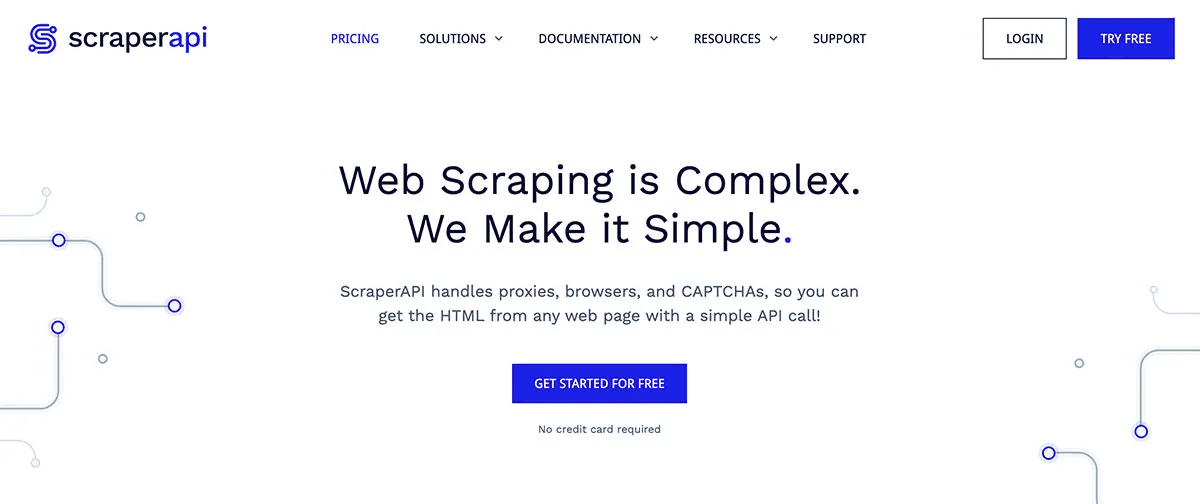
Not every team wants a point-and-click interface—sometimes you need a backend solution to pipe web data directly into your apps or databases. ScraperAPI is an API-first web extractor: you give it a URL, and it returns the raw HTML or extracted data, handling all the tricky stuff like proxies, geographic IP rotation, headless browsers, and CAPTCHAs for you ().
ScraperAPI maintains a pool of over 40 million proxies across 50+ countries and processes 36 billion requests per month (). It’s best for large-scale, automated scraping where reliability and anti-blocking are critical. You’ll need some coding chops to use it, but if you’re building data pipelines or integrating scraping into your product, ScraperAPI is a top choice.
Data Miner: Chrome Extension for Quick Web Page Extracting
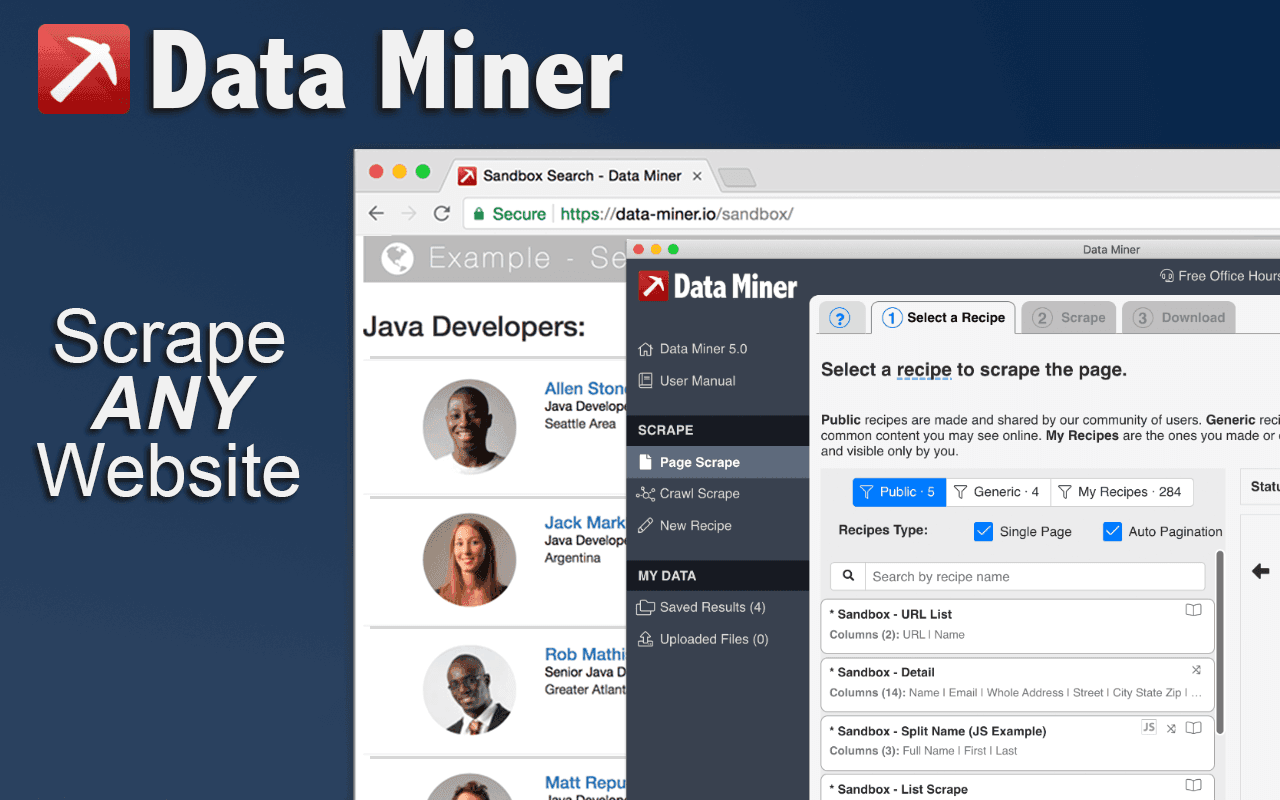
Data Miner is a Chrome extension built for business users and researchers who need to grab data quickly. It offers a point-and-click scraping experience and a library of pre-built scraping “recipes” for common patterns like tables, lists, or specific sites ().
Just install the extension, navigate to your target page, and click the Data Miner icon. Choose a recipe or create your own by selecting elements on the page. It’s great for one-off tasks or quick data needs—think sales reps pulling a list of leads from an online directory, or an e-commerce manager copying competitor prices.
Data Miner is simple, integrated into your browser, and perfect for interactive, on-demand scraping.
Simplescraper: No-Code Web Extractor for Instant Results
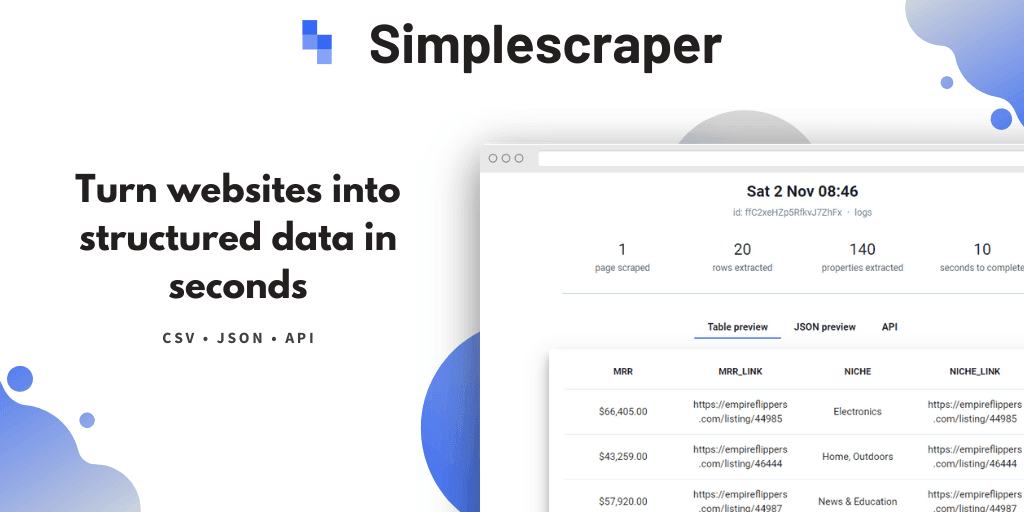
Simplescraper lives up to its name. It’s a no-code Chrome extension (and web app) that lets you visually select data on a page to create a “recipe” for extraction (). You can follow links to scrape subpages, handle pagination, and even turn your scrape into an API endpoint with one click.
Where Simplescraper shines is its integration options—you can send data directly to Google Sheets, Airtable, or tools like Zapier (). There’s also cloud scraping and scheduling for recurring jobs, and an “AI Enhance” feature to clean or analyze your data with GPT.
If you want quick results and easy integrations, Simplescraper is like the Swiss Army knife of lightweight web scraping.
Instant Data Scraper: Fast Web Extracting for Tables and Lists
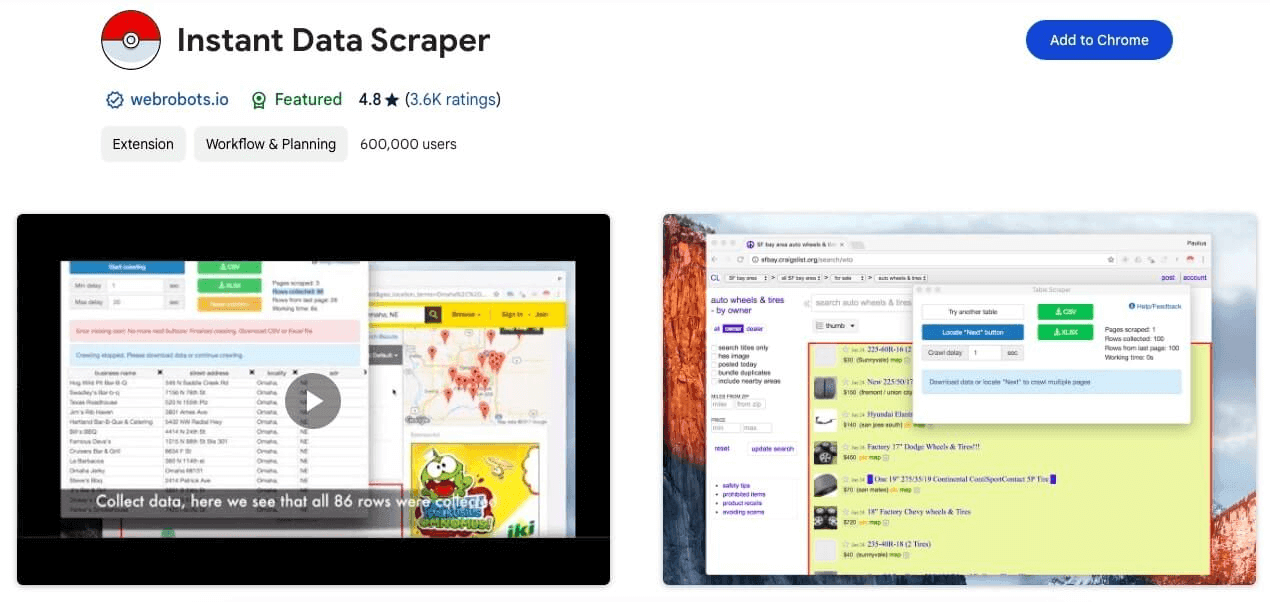
Sometimes you just want the data now, with zero setup. That’s where Instant Data Scraper (IDS) comes in. It’s a free Chrome extension known for its one-click scraping of tabular data (). Activate the extension, and IDS automatically detects tables or lists on the page. It even handles pagination and infinite scroll by auto-clicking through all pages.
IDS is 100% free, no sign-up, no coding, no waiting. It’s perfect for casual or urgent scraping needs—like a sales rep grabbing a quick list of leads, or a student pulling data from Wikipedia tables. If it finds your data, you’ll have it in seconds.
ScrapeStorm: Cloud-Based Web Extractor with AI Assistance
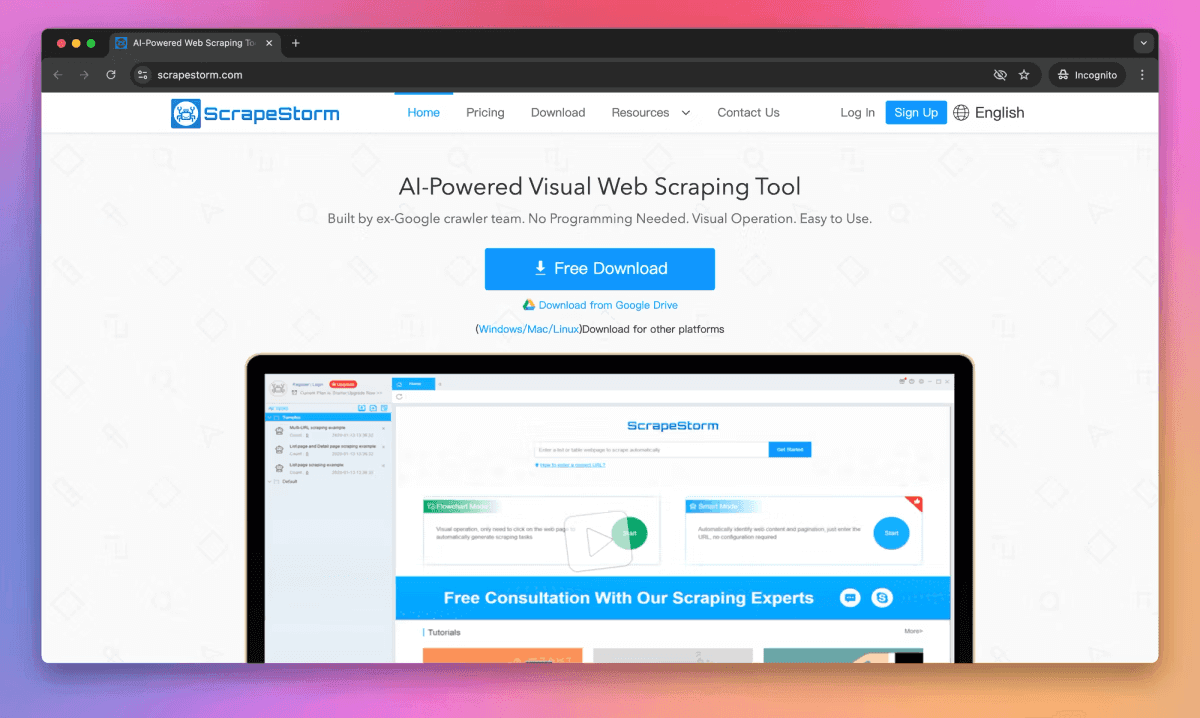
ScrapeStorm is an AI-powered web scraping tool that combines a visual interface with powerful AI algorithms (). You enter a URL, and its AI automatically identifies data fields—lists, tables, next-page buttons, and more.
ScrapeStorm supports cross-platform use (Windows, Mac, Linux) and offers both desktop and cloud-based scraping. You can schedule tasks, run multiple jobs in parallel, and export data in Excel, CSV, JSON, or even upload to a database (). It’s especially popular for e-commerce and market research, and can even parse data from images or PDFs using AI.
If you need a smart assistant for large-scale or complex scraping projects, ScrapeStorm is worth a look.
Apify: Web Extractor Marketplace and Automation Platform
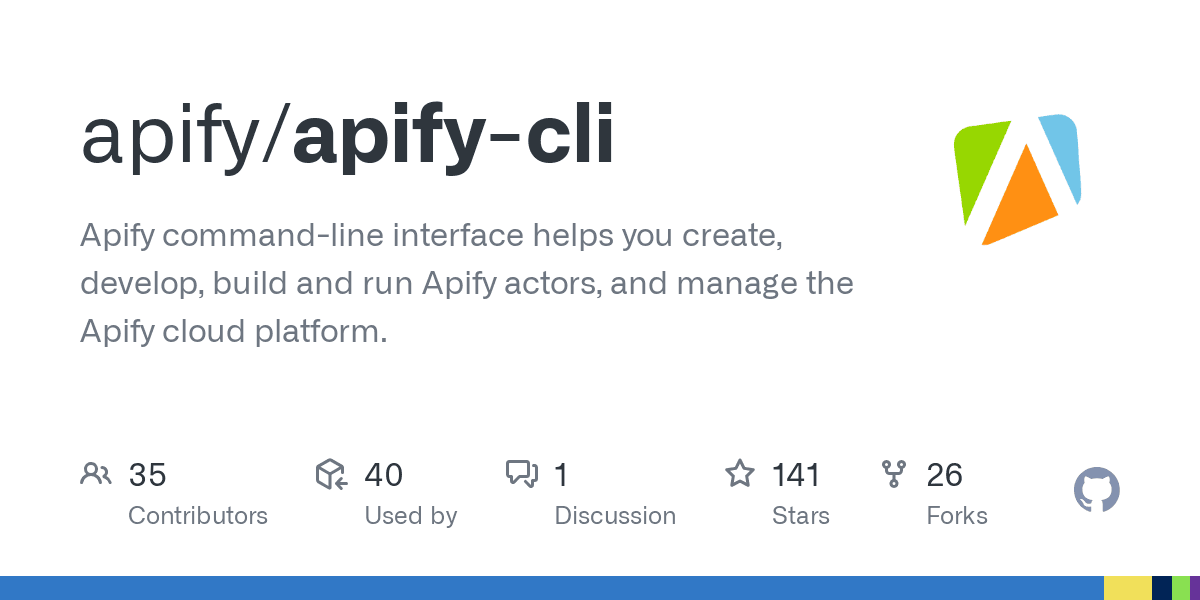
Apify isn’t just a scraper—it’s a web scraping and automation platform. You can run “actors,” which are scripts for scraping or browser automation. The real magic is Apify’s marketplace of pre-built actors for common tasks (). Need to scrape all reviews from an ecommerce site? There’s probably an actor for that.
For developers, Apify allows you to write your own scrapers in Node.js or Python and deploy them in the cloud. It’s scalable, automatable, and integrates via API. Apify is best for power users and organizations that treat web data as a key resource—think ongoing, large-scale scraping, or integrating scraping into your data pipeline.
ParseHub: Visual Web Page Extractor for Complex Sites

ParseHub is a desktop app (with cloud options) that’s known for handling complex, dynamic websites. You navigate through a site in a browser-like interface, click on data points, and ParseHub builds your scraper (). It supports conditional logic, nested scraping, AJAX content, and more.
ParseHub is often the go-to when other tools fail to scrape a site correctly. It’s used by researchers, analysts, and small business owners who need to tackle tricky websites. There’s a learning curve, but if you have a complex site to scrape and don’t want to code, ParseHub is a top option.
OutWit Hub: Desktop Web Extractor for Content Archiving
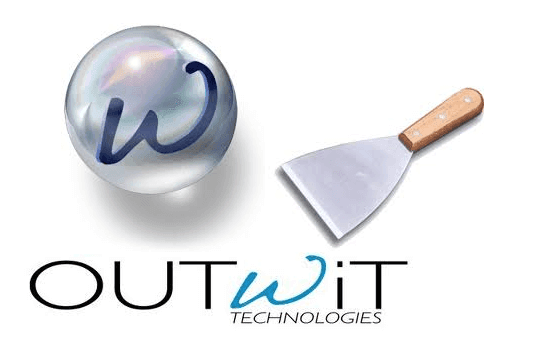
OutWit Hub is a bit old-school, but it’s a desktop application that’s great for grabbing lots of different types of content (links, images, email addresses, etc.) and organizing it (). It works like a browser combined with a spreadsheet—navigate to a page, and OutWit Hub can extract tables, lists, images, and more.
It’s especially handy for content archiving or research—like scraping all posts from a forum, or downloading a collection of files. It’s a desktop tool, so you run it locally and keep your data private. OutWit Hub is best for small to medium scraping tasks where you want a straightforward desktop interface.
Which Web Extractor Is Best for Your Needs?
Twelve tools, a thousand use cases. So which web extractor should you pick? Here’s my cheat sheet:
-
For total beginners or one-off quick tasks:
Try Instant Data Scraper for basic tables and lists (it’s free and instant). Data Miner is another user-friendly option with more templates if you’re often scraping similar pages.
-
For non-technical users needing ongoing scraping or integrations:
Thunderbit offers the easiest workflow with its AI-driven approach—perfect for business users who want results fast and often. Browse AI is ideal for continuous monitoring and alerts. Simplescraper is great if you want scraped data to flow into Google Sheets or an internal app through an API.
-
For complex websites or custom workflows without coding:
Choose a visual scraper like Octoparse or ParseHub. Octoparse is user-friendly and comes with lots of templates. ParseHub handles very complex dynamic sites and offers fine control. WebScraper.io is also great if you’re willing to configure your own sitemaps.
-
For developers or data engineers who need scale:
ScraperAPI is tailor-made for embedding web scraping into your software or doing large-scale projects. Apify is perfect when you need a scalable platform with a marketplace of ready-made or custom scripts.
-
For content-heavy extraction or offline use:
OutWit Hub is a solid pick for systematically collecting and archiving content, especially if you prefer a desktop tool for privacy or control.
Honestly, many teams use multiple tools depending on the job. You might start with Instant Data Scraper for something simple, switch to Thunderbit or Octoparse for a more involved project, and use ScraperAPI or Apify when you need to industrialize the process. The good news? Most of these tools have a free tier or trial, so you can experiment and see what fits.
Conclusion: The Future of Web Extracting for Business Teams
Web extractor tools have come a long way, and 2025 is the year they go mainstream. The big trend? Web scraping is becoming easier, more automated, and more integrated into daily workflows (). AI-driven scrapers mean even complex, dynamic websites can be tamed without specialized skills. As one data engineer put it, “Once AI web scraping tools came onto the market, I could complete tasks much faster and on a larger scale... with AI, [data cleaning] is automatically included in my workflow.”
Another big shift is the blurring of lines between scraping, monitoring, and automation. Tools like Browse AI and Thunderbit not only extract data but keep it updated and can even perform actions (like filling forms or triggering alerts). The surge in adoption is real—one major platform saw monthly active users jump by over 140% in a year (). Companies of all sizes are realizing that accessing public web data (ethically and legally) is key to staying competitive.
For business teams, the takeaway is empowerment. You don’t have to wait weeks for a developer or settle for gut-feeling decisions. The tools in this list put the power of web data in your hands, with interfaces and features tailored to real-world use cases in sales, marketing, operations, and beyond. And with the way things are evolving, I expect even more user-friendly interfaces, smarter AI, and deeper integration with BI and analytics platforms in the near future.
Just remember: respect websites’ terms of service and robots.txt rules, and make sure you’re compliant with data privacy laws. Ethical scraping is important for the sustainability of these practices.
So, whether you’re starting with a free extension or deploying an enterprise-grade scraping fleet, there’s never been a better time to turn the web’s information into actionable insights. The web extractor revolution is here—pick a tool, give it a try, and unlock the value hiding in plain sight. Your data-driven future is just a click away.
FAQs
1. What is a web extractor and why is it important for businesses in 2025?
A web extractor is a tool that helps users automatically gather structured data from websites. In 2025, it's crucial because it enables businesses to turn chaotic online information into actionable insights—boosting productivity, driving profitability, and eliminating manual data collection.
2. Who can use web extractors—do I need technical skills?
No technical skills are required for many modern web extractors. Tools like Thunderbit, Browse AI, and Instant Data Scraper are designed for non-technical users with intuitive interfaces, AI-powered automation, and no-code workflows.
3. How can sales, marketing, and operations teams benefit from web extractors?
Sales teams can build lead lists from online directories, marketing teams can monitor competitor pricing, and operations teams can automate data collection processes. These tools save time, reduce errors, and provide fresh, reliable insights for strategic decisions.
4. What should I look for when choosing a web extractor tool?
Key factors include ease of use, AI capabilities, automation/scheduling features, integration with tools like Google Sheets or Airtable, scalability, and relevance to your business use case (e.g., sales leads, price monitoring, content archiving).
5. Are there free or low-cost web extractor tools available?
Yes, many web extractors offer free tiers or affordable plans. Instant Data Scraper is entirely free for basic needs, while tools like Thunderbit, Simplescraper, and Data Miner offer generous free plans with upgrade options as needed.
Want to learn more about web extracting, AI scraping, or how to turn websites into your team’s next big advantage? Check out the for more guides, tips, and real-world stories from the front lines of data automation.